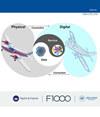Digital Twins along the product lifecycle: A systematic literature review of applications in manufacturing
引用次数: 0
Abstract
Background: The evolution of product expectations in the era of mass customization implies an improvement and a better control of individualized creation and production processes throughout the product lifecycle. The application of the digital twin (DT) seems to be a favoured solution in this context, but its study during the lifecycle of a product has only been partially evoked in the literature. Methods: The purpose of this state-of-the-art article is to identify current trends of applications of the digital twin concept in the literature under two main dimensions: its nature regarding the interaction structure between digital and physical objects (defined as: Pre-Digital Twin, digital model, digital shadow, and digital twin), but also its applications, along the product lifecycle (Design, Production, Operation, Disposal). To achieve this analysis a systematic literature review was carried out. The publications selection was based on the presence in this of a case of application of a digital twin with a focus in the Manufacturing sector. Within this review, 188 scientific papers were compiled and analyzed. Results: Results showed that although the term digital twin is widely used, the deployment of DT technologies in manufacturing is still at an early stage as most of the digital twin applications were in fact prototypes focused on the real-time observability of the physical system, either for optimization or predictive maintenance. Moreover, regarding the product lifecycle, most of the applications have been focused on the production and operational phases whereas those at the design and disposal phases are still limited. Conclusions: This paper presents an original approach to the study of digital twins, not focusing on a single application area or lifecycle phase but which aims to establish future perspectives on the use of digital twins along the lifecycle.产品生命周期中的数字双胞胎:制造业应用的系统文献综述
背景:大规模定制时代产品期望的演变意味着在整个产品生命周期中对个性化创作和生产过程的改进和更好的控制。在这种情况下,数字孪生(DT)的应用似乎是一个有利的解决方案,但其在产品生命周期中的研究只在文献中被部分唤起。方法:这篇最先进的文章的目的是在两个主要维度下确定文献中数字孪生概念应用的当前趋势:数字孪生与物理对象之间的交互结构的本质(定义为:前数字孪生,数字模型,数字阴影和数字孪生),以及其在产品生命周期(设计,生产,操作,处置)中的应用。为了进行这一分析,我们进行了系统的文献综述。出版物的选择是基于数字孪生应用案例的存在,重点是制造业。在本综述中,对188篇科学论文进行了汇编和分析。结果:结果表明,尽管数字孪生术语被广泛使用,但数字孪生技术在制造业中的部署仍处于早期阶段,因为大多数数字孪生应用实际上是专注于物理系统的实时可观测性的原型,无论是用于优化还是预测性维护。此外,就产品生命周期而言,大多数应用程序都集中在生产和操作阶段,而设计和处理阶段的应用程序仍然有限。结论:本文提出了一种研究数字孪生的原始方法,不关注单个应用领域或生命周期阶段,而是旨在建立整个生命周期中数字孪生使用的未来视角。
本文章由计算机程序翻译,如有差异,请以英文原文为准。
求助全文
约1分钟内获得全文
求助全文
来源期刊

Digital Twin
digital twin technologies-
自引率
0.00%
发文量
0
期刊介绍:
Digital Twin is a rapid multidisciplinary open access publishing platform for state-of-the-art, basic, scientific and applied research on digital twin technologies. Digital Twin covers all areas related digital twin technologies, including broad fields such as smart manufacturing, civil and industrial engineering, healthcare, agriculture, and many others. The platform is open to submissions from researchers, practitioners and experts, and all articles will benefit from open peer review.
The aim of Digital Twin is to advance the state-of-the-art in digital twin research and encourage innovation by highlighting efficient, robust and sustainable multidisciplinary applications across a variety of fields. Challenges can be addressed using theoretical, methodological, and technological approaches.
The scope of Digital Twin includes, but is not limited to, the following areas:
● Digital twin concepts, architecture, and frameworks
● Digital twin theory and method
● Digital twin key technologies and tools
● Digital twin applications and case studies
● Digital twin implementation
● Digital twin services
● Digital twin security
● Digital twin standards
Digital twin also focuses on applications within and across broad sectors including:
● Smart manufacturing
● Aviation and aerospace
● Smart cities and construction
● Healthcare and medicine
● Robotics
● Shipping, vehicles and railways
● Industrial engineering and engineering management
● Agriculture
● Mining
● Power, energy and environment
Digital Twin features a range of article types including research articles, case studies, method articles, study protocols, software tools, systematic reviews, data notes, brief reports, and opinion articles.
 求助内容:
求助内容: 应助结果提醒方式:
应助结果提醒方式:


